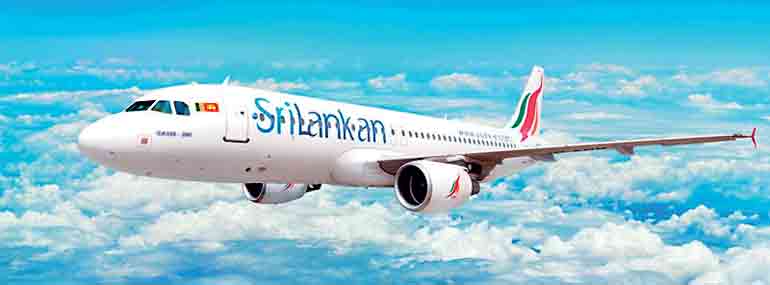Tuesday Nov 25, 2025
Tuesday Nov 25, 2025
Tuesday, 25 November 2025 01:32 - - {{hitsCtrl.values.hits}}

A history we prefer not to remember, but must
 SriLankan Airlines did not begin as the financial sinkhole it has become. Its most stable decade came under the Emirates partnership from 1998 to 2008, when commercial discipline, modern fleet planning and basic governance safeguards were in place. It was not perfect, but it worked profitably — because there was a buffer between the airline and political interference. That arrangement didn’t collapse because the model failed.
SriLankan Airlines did not begin as the financial sinkhole it has become. Its most stable decade came under the Emirates partnership from 1998 to 2008, when commercial discipline, modern fleet planning and basic governance safeguards were in place. It was not perfect, but it worked profitably — because there was a buffer between the airline and political interference. That arrangement didn’t collapse because the model failed.
It collapsed because politics and ego entered the cockpit. Once the State insisted on taking control, the airline’s commercial trajectory began to unravel.
The consequences were predictable. Over two decades, SriLankan became shaped by politically influenced aircraft decisions, prestige routes, procurement distortions, staffing inflation and shifting strategies that changed with every minister. The Mihin Lanka experiment (2007–2016) — which burnt over Rs. 17 billion before being folded back into UL — compounded the damage further.
At various points, SriLankan carried more than double the global industry benchmark of staff per aircraft. No carrier can survive long-term under that structural burden.
The accumulated cost: Over
Rs. 600 billion in losses — roughly $ 1.5–2 billion. Not an aviation failure. A governance failure of historic scale.
Why SriLankan failed: It was never allowed to be an airline
SriLankan did not fail because fuel was expensive, or because Gulf carriers were too strong, or because the market was unforgiving. It failed because it was never allowed to operate as a commercially run airline. Route decisions, staffing, procurement, fleet choices — all shaped for political reasons. Loss-making routes defended for prestige. Long-haul commitments made without commercial logic. A steady stream of Treasury guarantees shielding the airline from the consequences of its own decisions.
If SriLankan were a private business, it would have shut down years ago. Only political protection kept it airborne — and the bill now exceeds Rs. 600 billion.
SriLankan Airlines' most stable decade came under the Emirates partnership from 1998 to 2008, when commercial discipline, modern fleet planning and basic governance safeguards were in place. It was not perfect, but it worked profitably — because there was a buffer between the airline and political interference. That arrangement didn’t collapse because the model failed. It collapsed because politics and ego entered the cockpit. Once the State insisted on taking control, the airline’s commercial trajectory began to unravel
The national carrier argument has expired
Defenders still insist: “Every country needs a national carrier.” This is a 1960s–70s flag-carrier mindset, not a modern aviation requirement.
Even India — one of the world’s largest aviation markets — privatised Air India because the State could not run it efficiently.
Destinations like Maldives, Seychelles, Cyprus, Mauritius, and New Zealand thrive without large state-run national carriers.
Emirates and Singapore Airlines are Government-owned but operate with absolute commercial autonomy — the opposite of Sri Lanka’s model.
A national carrier is not a prerequisite for tourism or connectivity. For Sri Lanka, it is simply the most expensive business model possible.
SriLankan Airlines is not beyond saving. But the model under which it has operated for twenty years absolutely is
Tourism doesn’t need SriLankan to succeed
SriLankan Airlines carries less than 25% of tourist arrivals. Foreign airlines bring over 75%.
If SriLankan downscales or disappears, connectivity will not collapse.
Aviation hates a vacuum — profitable gaps are filled instantly.
And foreign carriers will fill the gap wherever demand exists. This is what happened in Cyprus, Hungary, India and Malaysia when struggling national carriers shut down or downsized.
Tourism does not rise and fall on a national airline. It rises and falls on fundamentals: destination marketing; visa consistency and clarity; stability and perception; value for money; safety; and digital visibility and accessibility. And these are precisely where Sri Lanka as a destination has struggled.
We have not had a sustained, professionally executed global marketing campaign for more than a decade. Campaigns such as “So Sri Lanka” (2018) and “Sri Lanka – You’ll Come Back for More” (2023) were inconsistent, short-lived and quickly abandoned. Meanwhile, Thailand, Malaysia and Vietnam execute multi-year destination marketing without interruption.
Visa policies have swung back and forth with little consistency — fees introduced, withdrawn, reintroduced, exemptions added then suddenly removed — sending mixed signals to travellers and industry partners.
Against such a backdrop, the opportunity cost becomes impossible to ignore.
The Rs. 600+ billion spent on keeping SriLankan airborne could have transformed Sri Lanka’s tourism proposition and global reach.
Over two decades, SriLankan became shaped by politically influenced aircraft decisions, prestige routes, procurement distortions, staffing inflation and shifting strategies that changed with every minister
What we must do now
The debt restructuring may improve the Balance Sheet, but it does not fix what caused the damage. Debt restructuring without governance restructuring is meaningless.
It buys time — it does not build a future.
The unavoidable truth: The model with the highest probability of success is majority private ownership.
Not because privatisation is ideological, but because commercial aviation cannot coexist with political interference. Sri Lanka has already run the State-owned experiment for two decades — and the bill stands at Rs. 600 billion.
To give SriLankan a viable future, ownership, oversight, capital and decision-making must shift to those guided by commercial discipline, not political incentives.
The Government must finally get out of the cockpit.
A future SriLankan: Strategy, not sentiment
A viable future does not require a long technical checklist. It requires clarity. SriLankan must become a lean, regionally focused carrier built around Colombo’s geography — serving South India, the Gulf, Southeast Asia and China — and expanding long-haul only when partnerships and demand justify it. No prestige routes. No political experiments. No sentimental commitments.
Commercial logic, professional management and strategic alliances — not nostalgia — must define the future.
Tourism does not rise and fall on a national airline. It rises and falls on fundamentals: destination marketing; visa consistency and clarity; stability and perception; value for money; safety; and digital visibility and accessibility. And these are precisely where Sri Lanka as a destination has struggled
Ground handling and catering: Keep them out of political hands
One principle is non-negotiable: the profitable ground handling and catering units must remain separate from political control.
They should be operated as independent, commercially managed entities — ideally through long-term concessions or PPP structures. What they must not become is subsidies to mask the airline’s losses or fuel patronage networks. Bundling them into the airline simply to make the Balance Sheet look better would repeat the same mistakes that brought SriLankan to this point.
The moment of truth
SriLankan Airlines is not beyond saving. But the model under which it has operated for twenty years absolutely is.
Nostalgia is not a strategy. After Rs. 600 billion, repetition is no longer an option.
(The writer is a business leader with extensive experience in hospitality, tourism, and corporate strategy. As Chairman and CEO of privately owned companies and a board member of three publicly listed companies, he is actively involved in hotel development, asset management, and investment ventures. He can be reached via [email protected])
Defenders still insist: “Every country needs a national carrier.” This is a 1960s–70s flag-carrier mindset, not a modern aviation requirement. Even India — one of the world’s largest aviation markets — privatised Air India because the State could not run it efficiently. Destinations like Maldives, Seychelles, Cyprus, Mauritius, and New Zealand thrive without large state-run national carriers. Emirates and Singapore Airlines are Government-owned but operate with absolute commercial autonomy — the opposite of Sri Lanka’s model